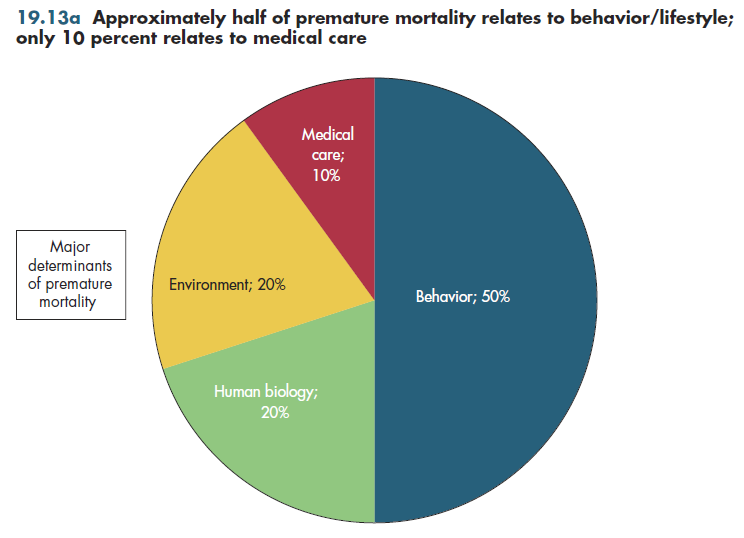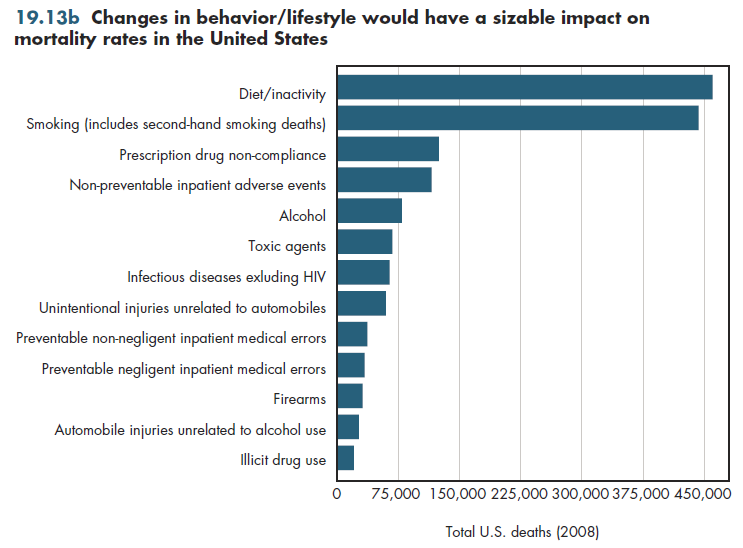Download PowerPoint versions of both figures.
Inside Collection (Book): American Health Economy Illustrated
19.13 Most "Avoidable" Deaths Are Related to Lifestyle or Behavior
Summary: Most "avoidable" deaths are related to lifestyle or behavior.
Approximately half of premature mortality is attributable to behavior or lifestyle (figure 19.13a). These include diet, physical activity, smoking, stress, alcohol or illicit drug abuse, injury or violence, and similar factors.

Human biology accounts for 20 percent of premature deaths. It refers to the individual's genetic makeup (which includes factors with which he or she is born, or mutations acquired over a lifetime) and family history (which can contribute both to risk for disease and/or the risk of dying from it when diagnosed).
Environmental factors account for another 20 percent of premature deaths. Researchers distinguish between the social environment (interactions with family, friends, coworkers, and others in the community) and the physical environment (things that can be seen, touched, heard, smelled, and tasted, and less tangible risks such as radiation or ozone). Social institutions, such as law enforcement, the workplace, places of worship, and schools, also are part of this environment. Housing, public transportation, and the presence or absence of violence in the community are other important components.
Access to medical care itself accounts for only 10 percent of premature mortality. The data shown are only approximate. First, they are estimates made 35 years ago. Second, the experts that developed them examined only the 10 leading causes of death in the United States, not all causes of death. Third, clearly important interactions exist between the categories. For example, behaviors can have a reciprocal relationship to biology, meaning that each can react to the other. For example, smoking (behavior) increases the odds of a heart attack (biology). A heart attack then can motivate an individual to stop smoking (behavior).
Even a cursory examination of the underlying causes of death in the United States underscores the importance of behavior and lifestyle (figure 19.13b). Smoking, poor diet and inactivity, and alcohol consumption alone accounted for approximately 40 percent (almost one million) of total deaths in the year 2008. The health care system is most directly implicated in deaths due to prescription drug non-compliance (125,000), non-preventable adverse patient events (116,000), infectious diseases excluding HIV (65,000)—some of which are avoidable—and preventable medical errors, both non-negligent (37,000) and negligent (34,000); together these account for 15 percent of all deaths.

Downloads
References
- Author's calculations.
- Department of Health, Education and Welfare. Office of the Surgeon General. Healthy People: The Surgeon General's Report on Health Promotion and Disease Prevention 1979.
- Department of Health and Human Services. Centers for Disease Control and Prevention.
- Department of Health and Human Services. Office of Inspector General. Medication Regimens: Causes of Non-Compliance. June 1990.
- Glantz SA and WW Parmley. Passive Smoking and Heart Disease: Mechanisms and Risk. Journal of the American Medical Association 1995; 273(13):1047-53.
- Goodman JC, P Villarreal and B Jones. The Social Cost of Adverse Medical Events, and What We Can Do about It. Health Affairs 2011; 30:590-95.
- Mokdad AH, JS Marks, DF Stroup and JL Gerberding. Actual Causes of Death in the United States, 2000. Journal of the American Medical Association 2004; 291(10):1238-45.
- Mokdad A, J Marks, DF Stroup and J Gerberding. Correction: Actual Causes of Death in the United States, 2000. Journal of the American Medical Association 2005; 293(3):293-94 (letter; correction of original study).
- Thomas EJ, DM Studdert, JP Newhouse, BI Zbar, KM Howard, EJ Williams and TA Brennan. Costs of Medical Injuries in Utah and Colorado. Inquiry 1999; 36(3):255-64.
Collection Navigation
- « Previous module in collection 19.12 US Has More Avoidable Deaths Amenable to Health Care among Industrialized Nations
- Collection home: American Health Economy Illustrated
- Next module in collection » 19.14 US Has World's Highest Obesity Rate but a Low Smoking Rate among Industrialized Nations
Content actions
Give feedback:
Download:
Add:
Reuse / Edit:
Twin Cities Campus:
- © 2012 Regents of the University of Minnesota. All rights reserved.
- The University of Minnesota is an equal opportunity educator and employer. Privacy
- Last modified on Sep 24, 2013 3:50 pm -0500









